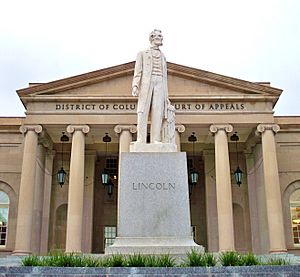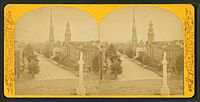Statue of Abraham Lincoln (District of Columbia City Hall) facts for kids
 |
|
| Coordinates | 38°53′42″N 77°01′03″W / 38.8949769°N 77.0175131°W |
|---|---|
| Location | 400 block of Indiana Ave NW Washington, D.C., U.S. |
| Designer | Lot Flannery (sculptor) Frank G. Pierson (architect) |
| Material | Marble (sculpture) Granite (base) |
| Length | 2.5 feet (0.76 m) |
| Width | 2.9 feet (0.88 m) |
| Height | 7.3 feet (2.2 m) |
| Opening date | April 15, 1868 |
| Dedicated to | Abraham Lincoln |
The Abraham Lincoln Statue is a beautiful marble sculpture of U.S. President Abraham Lincoln. It was created by Irish artist Lot Flannery. You can find it in front of the old District of Columbia City Hall in Washington, D.C., United States. This statue is the oldest memorial to President Lincoln that still exists in the country. It was placed just a few blocks from Ford's Theatre, where Lincoln was sadly assassinated. Lot Flannery, the artist, was actually at the theater on the night Lincoln died.
The statue was officially revealed on April 15, 1868. This was exactly three years after Lincoln's death. Important people like President Andrew Johnson and Generals Ulysses S. Grant, William Tecumseh Sherman, and Winfield Scott Hancock were there. The statue has been moved and rededicated two times since then. The first time was in 1923, after many people wanted it put back. The second time was in 2009, after the old City Hall was renovated. It used to stand on a tall column, but now it rests on a shorter, eight-sided base.
Contents
History of the Lincoln Statue
Why the Statue Was Built
Most people in Washington, D.C. were very shocked and sad when President Abraham Lincoln was assassinated. This happened on April 14, 1865. During the American Civil War, Washington, D.C., was sometimes thought to support the Southern states. Because Lincoln was killed there, some residents worried that leaders in Congress would be angry at the city.
To show their loyalty, city and business leaders decided to build a memorial. This decision was made just 13 days after Lincoln died. It was the first Lincoln monument planned after his death. However, it was not the first one actually built. A plaster statue of Lincoln was put up in San Francisco in 1866. This statue was later destroyed in the 1906 earthquake.
The Lincoln memorial in Washington, D.C., cost $25,000 to build. Most of the money came from donations by people living in Washington. The rest was raised by the Lincoln Monument Association. The biggest donation came from John T. Ford. He was the manager of Ford's Theatre when Lincoln was assassinated. He held a special show in his theater in Baltimore and raised $1,800.
Many designs were submitted for the monument. But the planning committee chose the design by Lot Flannery (1836–1922). He was a local Irish-American artist. They called his design the "most spirited" and "an excellent likeness." Flannery had actually known Lincoln. He was at Ford's Theatre the night Lincoln was killed. His statue is the only one of Lincoln made by someone who knew him. Frank G. Pierson was chosen to be the architect for the monument.
First Unveiling Ceremony
On the evening of April 14, 1868, the Lincoln statue was moved. It went from Flannery's studio to City Hall. The statue was covered and guarded by police. No one was allowed to see it before the dedication ceremony the next day. On April 15, all city offices closed at noon. All flags were flown at half-staff.
About 20,000 people attended the dedication. This was about 20% of Washington's population at the time! Important guests included President Andrew Johnson, General Ulysses S. Grant, General William Tecumseh Sherman, and General Winfield Scott Hancock. Supreme Court Justices and members of Congress were not there. This was because President Johnson's impeachment trial was happening.
A special ceremony took place, with music and prayers. Major General Benjamin Brown French gave the main speech. After the speech, Washington mayor Richard Wallach introduced President Johnson. Johnson then uncovered the statue. The crowd cheered loudly. More music played, and a final blessing was given.
Moving and Rededicating the Statue
In 1919, the memorial was taken apart. It was put into storage while City Hall was being renovated. Some city officials did not want the statue put back. This was because the much larger Lincoln Memorial was already being built. Others thought the tall base was unsafe.
When the public heard about plans to leave the statue in storage, many people were upset. Groups like the Grand Army of the Republic demanded the statue be put back. Even President Warren G. Harding asked Congress to help the angry citizens. Government officials agreed to put it back. But then, the statue went missing! It was later found in crates behind the Bureau of Engraving and Printing. It was cleaned up.
On June 21, 1922, a law was passed to allow the rededication. This second ceremony happened on April 15, 1923. This was 55 years after the first dedication. When the statue was put back, it was placed on a new, shorter base. This was instead of its original tall column. One problem with the shorter base was that vandals could easily reach the statue. Lincoln's fingers were broken off several times. His right hand even had to be replaced.
In 2006, the memorial was moved again. This was for more renovations at the old City Hall. This building is now home to the District of Columbia Court of Appeals. The statue was cleaned and repaired. It was returned when the renovations finished in 2009. On April 15, 2009, the memorial was rededicated for a second time. This was 144 years after its first unveiling. This statue is the oldest existing memorial to Lincoln in the United States. It is one of six statues in public places in Washington, D.C., that honor the assassinated president.
Statue Design and Location
The marble statue is located on Indiana Avenue NW. It stands in front of the old District of Columbia City Hall. This area is part of the Judiciary Square neighborhood. The statue itself is 7.3 feet (2.2 m) tall and 2.9 feet (0.88 m) wide. Its granite base is 6.4 feet (2.0 m) high and 7 feet (2.1 m) wide.
The statue shows Abraham Lincoln standing. He is wearing a long coat, a bow tie, and a waistcoat. His left hand rests on a fasces, which is a bundle of rods. His right arm is by his side. Lincoln's right hand is partly open and points to the ground. He is looking to his left. The right hand was replaced at some point. The new hand is thought to be a bit too big compared to the rest of the statue. A sword or scroll used to hang by his right side, but it is now missing. The base has two parts: a rectangle on top of a larger square foundation.
The statue originally stood on a very tall marble column. This column was 18 feet (5.5 m) high. It was on top of a 6-foot (1.8 m) high eight-sided base. A reporter once asked Lot Flannery why the statue was placed so high. He replied: "I lived through the days and nights of gloom following the assassination. As to every one else, it was a personal lamentation. And when it fell to me to carve and erect this statue I resolved and did place it so high that no assassin's hand could ever again strike him down."
The monument has some words carved into it:
- Lot Flannery, Sculptor (on the back of the statue)
- LINCOLN (on the front of the base)
- ABRAHAM LINCOLN / 1809–1865 / THIS STATVE WAS ERECTED / BY THE CITIZENS OF THE / DISTRICT OF COLVMBIA / APRIL 15 1868 / RE-ERECTED APRIL 15 1923 / VNDER ACT OF CONGRESS / OF JVNE 21 1922 (on the back of the base)
- Frank G. Pierson, Architect (on the lowest part of the back base)
See also
 In Spanish: Estatua de Abraham Lincoln (Ayuntamiento del Distrito de Columbia) para niños
In Spanish: Estatua de Abraham Lincoln (Ayuntamiento del Distrito de Columbia) para niños





